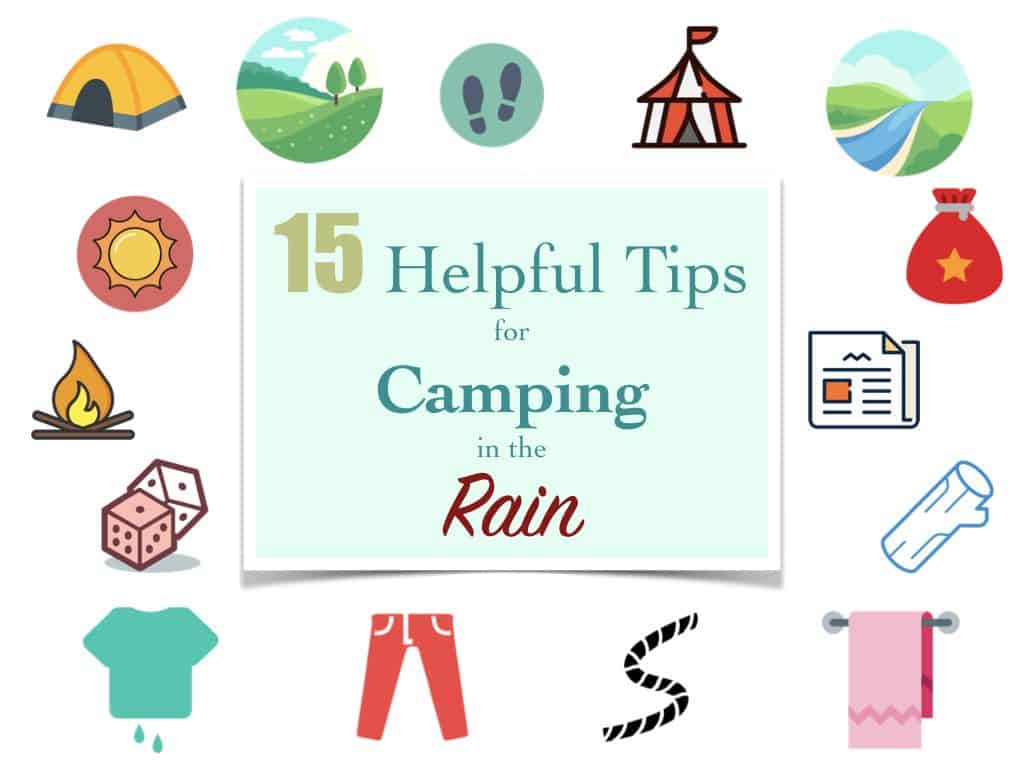So, you’re about to head out for your next camping trip, but soon discover the weather won’t be cooperating… Oh no, it’s going to rain!
Wait! Before giving up and canceling your trip all-together, consider these 15 tips for how to camp in the rain.
Because, whether it’s a light sprinkle or a torrential downpour, these tips will have you camping blissfully and singing in the rain! (metaphorically speaking)


1. Bring a Waterproof Tent
Tents come in a wide variety of ratings and weatherproofing. Some are purpose built for hot, dry climates, while others are meant for wet weather. Generally, a tent that has a waterproof base and fly will keep out even the peskiest water molecules.
If you’re considering buying a tent, check its waterproof rating. Waterproof ratings are measured in millimetres. The higher the value, the higher the water pressure the fabric can withstand. For example, a 1000 mm rated tent can withstand 1000 mm (one meter) of water column above it before it starts to leak.
The last thing you want while camping in the rain is to wake up in a pool of water in your tent.
Pro tip: If you’re bringing an older tent, make sure the seams are still fully waterproof. If you spot leaks, you can easily fix them with sealing compound. This step-by-step repair guide will show you How To Repair a Tent Seam.

2. Pick the Right Campsite
When you arrive at your campsite, the first inclination you might have is to just start setting up your gear. However, picking the right spots for your tent and cooking and lounging area is very important.
Flat, low laying areas are mini pools waiting to be filled. And, if you’re not careful, you’ll be wading through water with wet gear if it starts to rain heavily.
Instead, look for high spot that is slightly sloped. This ensures water will not collect under or around your tent. Try not to set up your tent under any trees, since after it rains, the leaves and branches will continue to dropping water on your tent.
Pro tip: Your cooking and lounging area should be positioned in location where you can set up tarps easily. Trees or large structures provide the perfect anchors for tarp lines. Again, make sure the area isn’t a low point, and that any rain water flows away.

3. Use a Tent Footprint
Nowadays, many tents come with a footprint that you place on the ground before setting up your tent on top. A footprint helps protects the bottom of your tent from sharp objects, as well as acts as an added barrier against water that may collect under your tent.
A tent footprint can be purchased online or even made home. Just take a regular tarp and cut it to slightly smaller dimensions than the base of your tent (2 inches smaller should be good). This ensures any rain water doesn’t get in between the tent and the footprint.

4. Set up a Covered Cooking / Social Area
Many campers dread the thought of camping in the rain because they think they’ll be stuck inside their tent for hours on end.
Well, an easy way to address that is to set up a separate covered cooking and social area.If your campsite has a picnic table, hang a large tarp over it for a dry area to cook your meals and to lounge.
Better yet, bring a pop-up canopy tent! It’s large enough to set up over a picnic table, or to set up your chairs and cooler inside. And, as an added bonus, it’ll keep out any bugs and mosquitos.
This way, kids and adults won’t have to be cooped up in a tent all day long if it starts to rain. A dry camper is a happy camper!

5. Divert and Channel Rain Water Away
When it eventually does starts to rain heavily enough, water will start to snake a path downhill in little streams. If possible, try to divert these streams away from your tent and other gear.
If the ground is loose, take a stick and carve out a path that diverts rain water around and away from your gear. Use rocks and dirt to create mini dams and berms to keep ground water at bay.
Likewise, when setting up tarps, make sure any water that beads off runs away from your gear and campsite.

6. Pack Gear in Dry Bags
Trust me, putting on dry clothes during a wet camping trip can feel like nirvana.
So, to keep your dry clothes dry, consider using heavy duty dry bags. Dry bags are completely waterproof and will prevent rain water from dampening your t-shirts (and spirits!).
These dry bags from Amazon are relatively inexpensive and come in a variety of sizes. To use them, simply place your clothes inside, roll the top closed and clip the buckle.
Now you won’t have to worry walking around in wet socks all day long!

7. Bring Newspaper
Newspaper is multi-functional on a camping trip. Not only will you be able to keep up-to-date with the latest political rhetoric, you can use it for a wide variety of tasks.
Newspaper is a great fire starter, especially in wet conditions. When making a fire, set up your fire base beforehand then use rolls of newspaper to catch and spread the flames.
Newspaper can be used to absorb moisture collected inside your tent or wipe away water on your gear. Likewise, it can be used to absorb water and moisture in shoes.
And, the wet paper can then be tossed into your fire as added fuel!

8. Keep Firewood Dry
A camping fire, even in wet conditions, is a camping must, so having a dry supply of firewood is very important.
Large logs don’t necessarily need to be fully out of the rain. However, split pieces expose more of the wood which can become damp and harder to burn.
Place your supply of firewood under your tarp, picnic table or pop-up canopy. If your tent has vestibules, tuck firewood there to keep them out of the rain.
Pro tip: Make extra tinder and keep it in a dry bag.

9. Bring a Quick-Dry Towels
Quick dry towels come in super handy while camping. You can wipe of your gear and yourself, ring it out and use it again and again.
Quick-dry towels come in a range of sizes. Smaller ones are good to keep in a tent to wipe away condensation. Larger ones are great to dry yourself off with after a dip in the lake.
They can be hung up and dry very quickly under the sun or next to a fire.

10. Hang a Dry Line
Soon after setting up your tent and covered cooking/lounging area, it’s best to string up a dry line. Wet clothes, towels and other gear can be hung across to dry when the sun eventually comes out.
Make sure your dry line isn’t strung across any main pathways in your campsite because at night it can turn into a close-line, the wrestling type. Paracord is the best rope to use since it is thin, yet strong and won’t stretch much after getting wet.

11. Pack Rain pants or Gaiters
Packing a waterproof shell jacket is a must for any camping trip. However, waterproof pants are incredibly useful if you need to spend extended time exposed to the rain.
Consider packing a Gore-Tex pant shell with adjustable ankle straps so you can slip them on even while wearing boots.
And when it stops raining, switch your pants for gaiters to keep your lower legs water-free as you walk through wet grass or low brush.

12. Wear Synthetic Fabrics
Certain fabrics tend to take forever to dry while others wick away moisture easily. In rainy conditions, you want to wear quick-drying, breathable or waterproof clothes to maintain your warmth.
Knowing this, be wary of wearing cotton – it won’t be your friend in the rain. Once it gets wet, it’ll tend to stay wet, become uncomfortable and eventually irritate your skin.
Synthetic fabrics like polyester and nylon, and natural materials like merino wool are fantastic alternatives. These materials will keep you warm even if they are wet. A merino wool base layers is a must for cooler camping trips and great for wet weather. Also, wool socks are the best!

13. Don’t Rely on a Fire for Cooking
Many novice campers often make the mistake of relying on a campfire to cook meals. Yes, you could toss a grill onto a fire pit and heat pots and pans on a raging fire. But, if it starts to rain while you’re camping, the last thing you want is a soupy stir-fry or a water-logged omelette.
A butane or propane fueled stove is highly recommended if rain is in the forecast. You can set them up under your sheltered area, on top of a picnic table and cook like you’re in your home kitchen.
For individuals and couples, a single burner, butane stove will do the trick. For smaller groups, a dual burner, propane fueled stove is good. And for larger families, a stand-up, propane tank fuelled stove is perfect.

14. Bring Games, Lots of Games
I’ll admit it, waiting for the rain to stop while camping is one of the most boredom inducing things on the planet. So, what’s the perfect remedy… board games!
Board games can turn a sudden rainstorm into an opportunity for espionage, social deduction or cooperative play. Whether it’s a quick 15 minutes, or an epic 2-hour showdown, board games can keep campers happily busy.
Some of my favorite games to bring are Monopoly Deal, Splendor, Carcassonne, Citadels and Ticket to Ride.
For more information about these board games, including why they’re amazing to play, check out Two-Player Board Games and Top Office-Friendly Board Games.

15. Air-Out Gear at Home
Finally, after a rain-filled (and hopefully still an enjoyable) camping trip your gear could use a proper drying. Letting your gear properly dry will help prevent bacteria and mold from developing, and can increase the life of your gear.
When you get home, air-out and fully dry your tent, chairs, tarps, ropes and all other camping gear before storing them away. On a warm day at home, unwrap your tent and let it dry out under the sun. If you don’t have access to a yard, drape your tent on a balcony and secure it down so it doesn’t blow away. Shake off any debris that my have stuck to the outside and inside of the tent. Then refold it back into its bag.
So, the next time your ready to go camping, you won’t have a smelly and soggy tent to begin with.
Rain or shine, I hope you can enjoy camping more because of these tips!
What do you do to prepare for a camping trip if it might rain? Share your thoughts in the comment section below!
This article contains affiliate links, which help support this blog at no cost to you!
